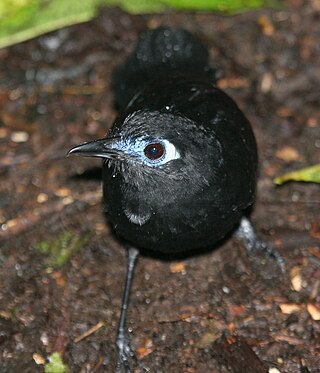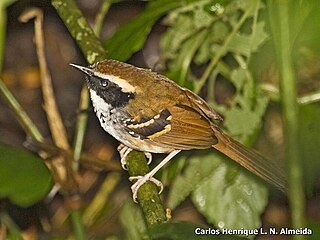
The chestnut-backed antbird is a passerine bird in the antbird family. It is found in humid forests in Central and South America (Chocó-Magdalena), ranging from eastern Nicaragua to western Ecuador. It mainly occurs in lowlands up to an altitude of 900 metres (3,000 ft) m, but locally it occurs higher.

The bicolored antbird is a species of bird in the family Thamnophilidae. It is found in Honduras south to Panama, western Colombia and Ecuador. Its natural habitat is subtropical or tropical moist lowland forest.

Gymnopithys is a genus of passerine birds in the antbird family, Thamnophilidae.

The spotted antbird is a species of bird in the family Thamnophilidae. In southern Central America, it is found in Honduras, Nicaragua, Costa Rica and Panama; also Colombia and Ecuador of northwestern South America. Its natural habitat is subtropical or tropical moist lowland forests.

The spot-backed antbird is a species of bird in the family Thamnophilidae, the antbirds. It is found in Bolivia, Brazil, Colombia, Ecuador, French Guiana, Guyana, Peru, Suriname, and Venezuela. Its natural habitats are subtropical or tropical moist lowland forests and subtropical or tropical swamps.

The common scale-backed antbird is a species of passerine bird in the antbird family, Thamnophilidae. It is found in the Amazon of Bolivia, Brazil, Colombia, Ecuador, French Guiana, Guyana, Peru, Suriname, and Venezuela. Its natural habitat is tropical moist lowland forests. As with other species of antbirds, it regularly follows swarms of army ants as they flush insects and other arthropods out of the leaf litter.

Hypocnemis is a genus of passerine birds in the family Thamnophilidae. They are resident breeders in tropical Central and South America.

The stripe-backed antbird is a species of bird in the family Thamnophilidae. It is monotypic within the genus Myrmorchilus. It is found in Argentina, Bolivia, Brazil and Paraguay, where its natural habitat is subtropical or tropical dry forests.

The ocellated antbird is a species of antbird in the family Thamnophilidae. It is monotypic within the genus Phaenostictus and is found in southern Central America and the northwestern part of South America. Its natural habitat is the understory of tropical moist lowland forest, foothill forest, and tall secondary growth woodlands.

Phlegopsis is a genus of insectivorous passerine birds in the antbird family, Thamnophilidae. They are known as "bare-eyes", which is a reference to a colourful bare patch of skin around their eyes. They are restricted to humid forest in the Amazon of South America. They are among the largest ant-followers in the family and are only rarely seen away from ant swarms.

Rhegmatorhina is a genus of insectivorous passerine birds in the antbird family, Thamnophilidae.

The hairy-crested antbird is a species of bird in the family Thamnophilidae. It is found in Bolivia, Brazil, Colombia, Ecuador, and Peru. Its natural habitat is subtropical or tropical moist lowland forests.

Myrmelastes is a genus of passerine birds in the family Thamnophilidae. Most of these species were previously placed in the genus Schistocichla. The genus formerly included only three species, but several taxa previously considered subspecies of the spot-winged antbird have been elevated to species status.

Willisornis is a genus of insectivorous passerine birds in the antbird family, Thamnophilidae. These small, strongly sexually dichromatic birds are native to the Guianas and Amazon rainforest in South America, and often follow army ants.

Isleria is a genus of insectivorous birds in the antbird family, Thamnophilidae.

Zeledon's antbird is a species of antbird in the family Thamnophilidae. It is found at low levels in humid forests from Nicaragua to Panama, and in the Chocó of western Colombia and western Ecuador. Zeledon's antbird feeds on insects, and regularly follows swarms of army ants in order to catch prey flushed by the swarms, but it is not an obligate ant-follower like some species of antbirds.

The riparian antbird is a species of passerine bird in the family Thamnophilidae. It is found in southern Colombia, eastern Ecuador, eastern Peru, northern Bolivia and southwestern Amazonian Brazil. Its natural habitats are subtropical or tropical moist lowland forests, and adjacent thickets on sandbars and riverbanks.

Myrmoderus is a genus of passerine birds in the family Thamnophilidae.

Edwin O'Neill Willis was an American ornithologist who studied the birds of Central and South America.
















